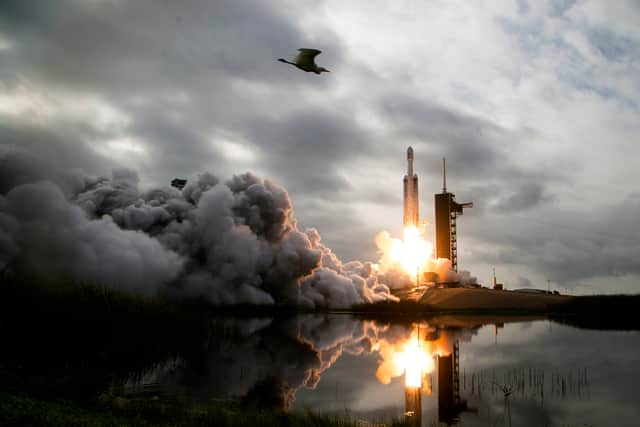Psyche: Nasa launches probe to metal asteroid 16 Psyche
and live on Freeview channel 276
American space agency, Nasa, has launched a probe to one of the strangest objects in the universe - an asteroid called 16 Psyche.
The craft, known as Psyche, is heading to the metal asteroid - which telescopic observations have suggested is made from up to 60% iron and nickel - after being launched on Friday 13 October on a six-year journey.
Advertisement
Hide AdAdvertisement
Hide AdScientists believe the asteroid may be the battered remains of an early planet’s core, and could shed light on the inaccessible centres of Earth and other rocky planets.


SpaceX launched the spacecraft into a midmorning sky from Nasa’s Kennedy Space Centre in Florida and Psyche should reach the huge, potato-shaped object in 2029.
Of the nine or so metal-rich asteroids discovered so far, Psyche is the biggest, orbiting the sun in the outer portion of the main asteroid belt between Mars and Jupiter alongside millions of other space rocks. It was discovered in 1852 and named after Greek mythology’s goddess of the soul.
Lead scientist Lindy Elkins-Tanton of Arizona State University said: “It’s long been humans’ dream to go to the metal core of our Earth. I mean, ask Jules Verne. The pressure is too high. The temperature is too high. The technology is impossible. But there’s one way in our solar system that we can look at a metal core and that is by going to this asteroid.”
Advertisement
Hide AdAdvertisement
Hide AdAstronomers know from radar and other observations that the asteroid is about 144 miles (232km) across at its widest and 173 miles (280km) long and it is believed to be brimming with iron, nickel and other metals, and quite possibly silicates, with a dull, predominantly grey surface likely covered with fine metal grains from cosmic impacts.
If the spacecraft reaches the asteroid, it will have travelled more than two billion miles. Scientists envision spiky metal craters, huge metal cliffs and metal-encrusted eroded lava flows greenish-yellow from sulfur — “almost certain to be completely wrong”, according to Ms Elkins-Tanton.
There may be a possibility that trace amounts of gold, silver, platinum or iridium — iron-loving elements — could be dissolved in the asteroid’s iron and nickel, she said. “There’s a very good chance that it’s going to be outside of our imaginings, and that is my fondest hope,” she added.
Believed to be a planetary building block from the solar system’s formation 4.5 billion years ago, the asteroid can help answer such fundamental questions as how life arises on Earth and what makes our planet habitable, according to Elkins-Tanton. On Earth, the planet’s iron core is responsible for the magnetic field that shields our atmosphere and enables life.
Advertisement
Hide AdAdvertisement
Hide AdLed by Arizona State University on Nasa’s behalf, the $1.2bn dollar (£1bn) mission will use a roundabout route to get to the asteroid. The van-size spacecraft with solar panels big enough to fill a tennis court will pass Mars for a gravity boost in 2026, and in 2029, it will reach the asteroid and attempt to go into orbit around it, circling as high as 440 miles (700km) and as close as 47 miles (75km) until at least 2031.
The spacecraft relies on solar electric propulsion, using xenon gas-fed thrusters and their gentle blue-glowing pulses. An experimental communication system will use lasers instead of radio waves in an attempt to expand the flow of data from deep space to Earth. Nasa expects the test to yield more than 10 times the amount of data, enough to transmit videos from the moon or Mars one day.
Comment Guidelines
National World encourages reader discussion on our stories. User feedback, insights and back-and-forth exchanges add a rich layer of context to reporting. Please review our Community Guidelines before commenting.
